


Tenable Vulnerability Management and Microsoft Defender for Cloud are prominent competitors in the realm of cyber security, specifically in vulnerability management and cloud security. Microsoft Defender for Cloud appears to have the upper hand due to its intuitive interface and comprehensive cloud security management capabilities.
Features: Tenable Vulnerability Management is noted for its advanced vulnerability scanning, seamless integration with various systems, and comprehensive management tools, making it a standout option for enterprise-level organizations. Microsoft Defender for Cloud's strength lies in its advanced threat intelligence, robust multi-cloud environment monitoring, and a single pane of visibility, which helps organizations effectively manage security threats across multiple cloud platforms.
Room for Improvement: Tenable can enhance its user interface, offer better dashboard customization, and provide more affordable solutions for SMBs to address cost concerns. Microsoft Defender for Cloud needs to improve pricing transparency, deepen integration with third-party tools, and allow more customization in compliance settings. Furthermore, more granular alert systems and a reduction in false positives are desired features by its users.
Ease of Deployment and Customer Service: Tenable exhibits satisfactory deployment across public, private cloud, and on-premises setups. Customer service receives mixed feedback, with some users experiencing delays in response times. Microsoft Defender for Cloud performs well in public cloud settings, offering more consistent support, though there are still criticisms regarding the response times and depth of technical assistance.
Pricing and ROI: Tenable is considered expensive, with suggestions for a more flexible pricing model like pay-as-you-go to improve ROI and accessibility for SMBs. Microsoft Defender for Cloud provides a blend of fixed and flexible pricing options seen as competitive yet intricate. Its ROI is positively influenced by its integration within broader Microsoft suites, appealing due to its cost-effective bundling, although concerns over feature-specific pricing persist.
| Product | Market Share (%) |
|---|---|
| Tenable Vulnerability Management | 4.6% |
| Microsoft Defender for Cloud | 5.3% |
| Zafran Security | 1.1% |
| Other | 89.0% |



| Company Size | Count |
|---|---|
| Small Business | 26 |
| Midsize Enterprise | 7 |
| Large Enterprise | 45 |
| Company Size | Count |
|---|---|
| Small Business | 20 |
| Midsize Enterprise | 2 |
| Large Enterprise | 21 |
Zafran Security integrates with existing security tools to identify and mitigate vulnerabilities effectively, proving that most critical vulnerabilities are not exploitable, optimizing threat management.
Zafran Security introduces an innovative operating model for managing security threats and vulnerabilities. By leveraging the threat exposure management platform, it pinpoints and prioritizes exploitable vulnerabilities, reducing risk through immediate remediation. This platform enhances your hybrid cloud security by normalizing vulnerability signals and integrating specific IT context data, such as CVE runtime presence and internet asset reachability, into its analysis. No longer reliant on patch windows, Zafran Security allows you to manage risks actively.
What are the key features of Zafran Security?
What benefits can users expect from Zafran Security?
In industries where security is paramount, such as finance and healthcare, Zafran Security provides invaluable protection by ensuring that only exploitable vulnerabilities are addressed. It allows entities to maintain robust security measures while allocating resources efficiently, fitting seamlessly into existing security strategies.
Microsoft Defender for Cloud is a comprehensive security solution that provides advanced threat protection for cloud workloads. It offers real-time visibility into the security posture of cloud environments, enabling organizations to quickly identify and respond to potential threats. With its advanced machine learning capabilities, Microsoft Defender for Cloud can detect and block sophisticated attacks, including zero-day exploits and fileless malware.
The solution also provides automated remediation capabilities, allowing security teams to quickly and easily respond to security incidents. With Microsoft Defender for Cloud, organizations can ensure the security and compliance of their cloud workloads, while reducing the burden on their security teams.
Managed in the cloud and powered by Tenable Nessus, Tenable Vulnerability Management (formerly Tenable.io) provides the industry's most comprehensive vulnerability coverage with real-time continuous assessment of your organization. Built-in prioritization, threat intelligence and real-time insight help you understand your exposures and proactively prioritize remediations.
We monitor all Vulnerability Management reviews to prevent fraudulent reviews and keep review quality high. We do not post reviews by company employees or direct competitors. We validate each review for authenticity via cross-reference with LinkedIn, and personal follow-up with the reviewer when necessary.